Milan, from November 19 to December 31, 1966.
- "Demonstration of Handcuffs".
- Death of Gennaro De Miranda.
- The merger of Mondo Beat, Onda Verde, Provos.
- "Demonstration of Flowers".
- Printing of the second issue of Mondo Beat magazine.
- The European Conference of Anarchist Youth.
- Hundreds of boys and girls from all walks of life and from all over Italy join the Mondo Beat Movement.
The day after Vittorio Di Russo was arrested in the underpasses of Cordusio metro station while he distributed copies of Mondo Beat magazine, we decided to make a demonstration for his release. Thus we contacted Milanese anarchists and radicals to get them to participate.
The three groups coordinated and on the morning of Sunday 27 they staged a demonstration in the heart of Milan, Piazza San Babila. It was the first time a demonstration organized by extra-parliamentary groups took place in Italy. Called "Demonstration of Handcuffs" (Manifestazione delle Manette), it received a wide media coverage, the Milanese newspaper Il Giorno published article and pictures on the front page.
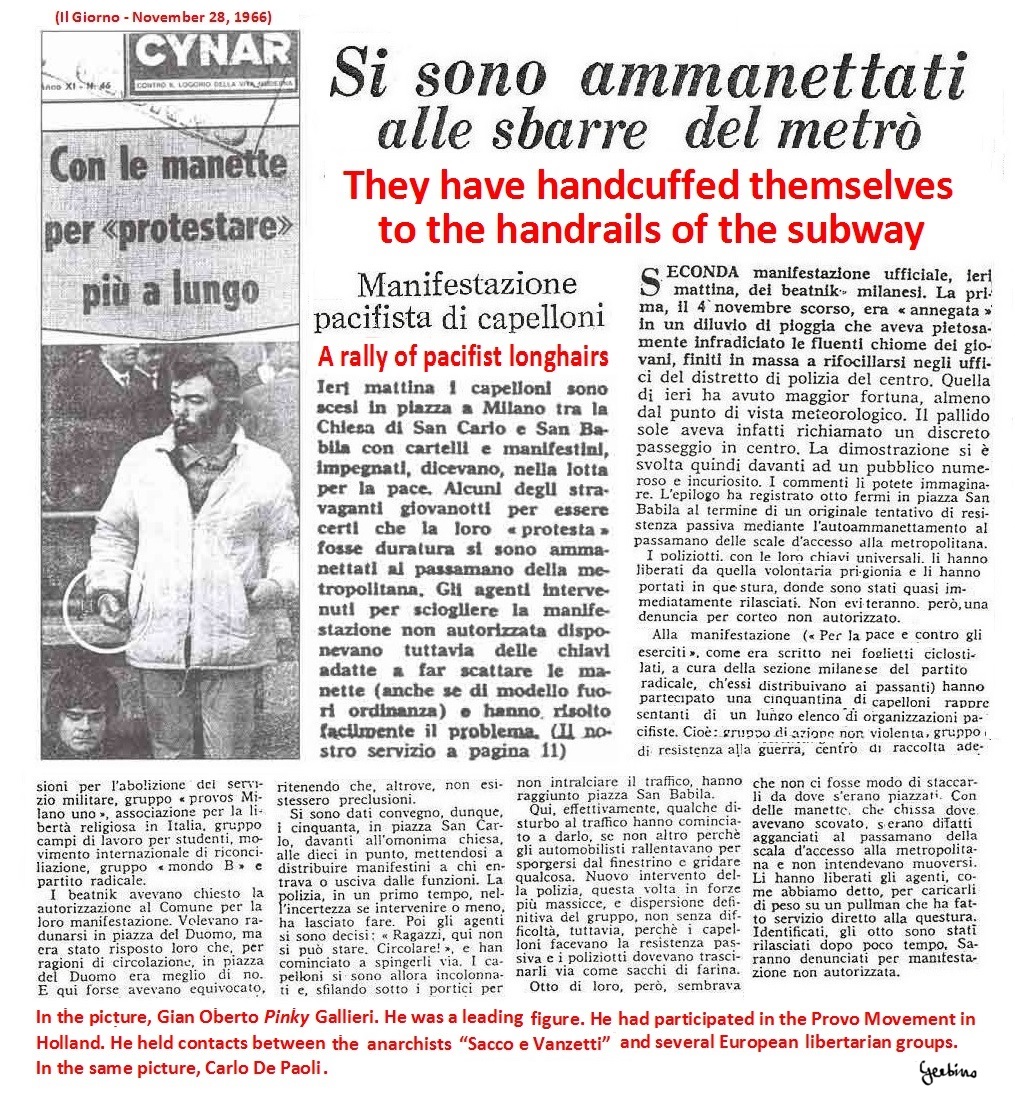
Gianoberto Pinky Gallieri and Carlo De Paoli, sitting lower. (Il Giorno)
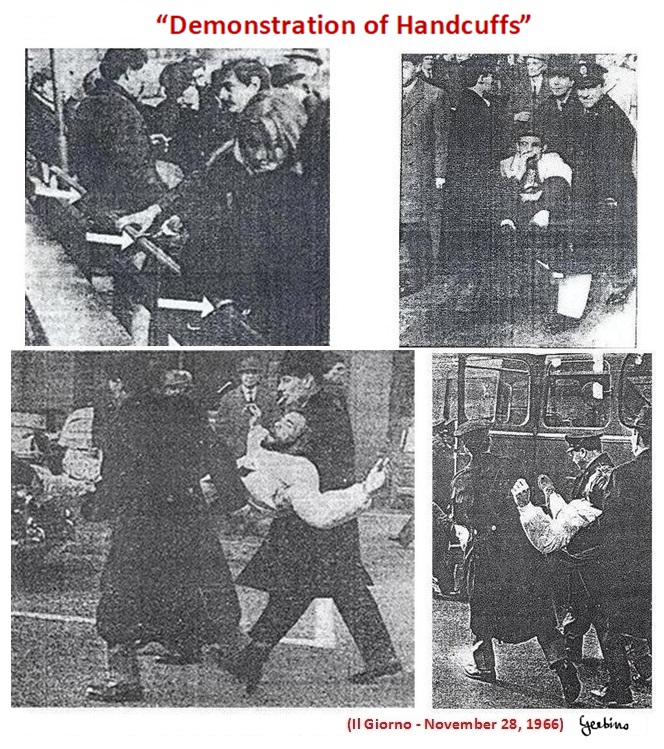
First photo top left, activists handcuffed to the railing of San Babila metro station entrance.
Second photo, Roberto Pieraccini, from the Milanese radicals, carried away by the police.
Third and fourth photos, Gianoberto Pinky Gallieri carried away by the police. (Il Giorno)
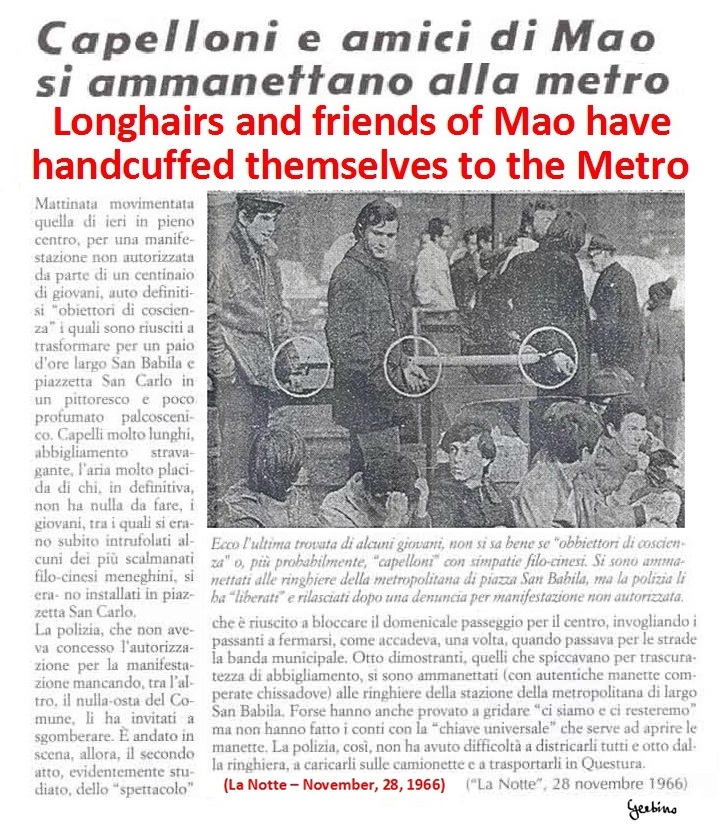
Activists handcuffed to the railing of San Babila metro station entrance. (La Notte)
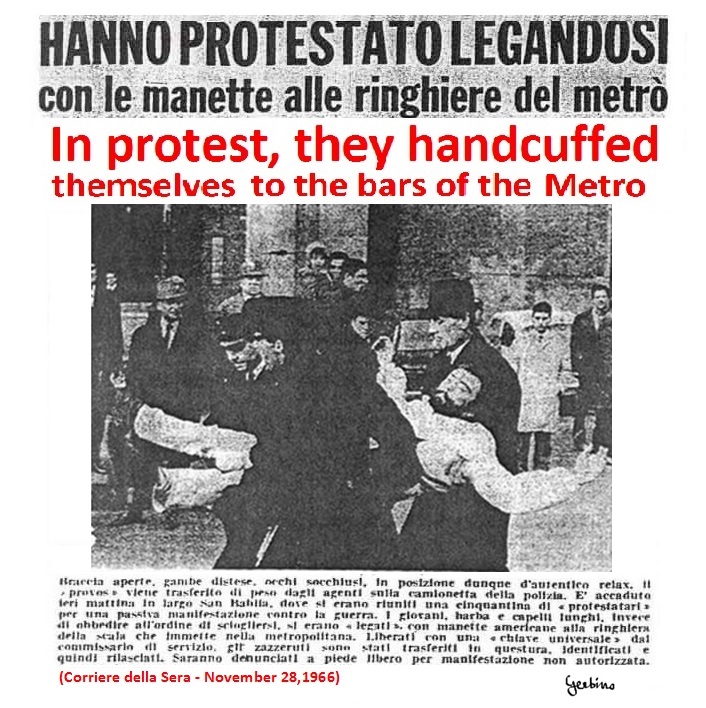
Gianoberto Pinky Gallieri carried away by the police. (Corriere della Sera)
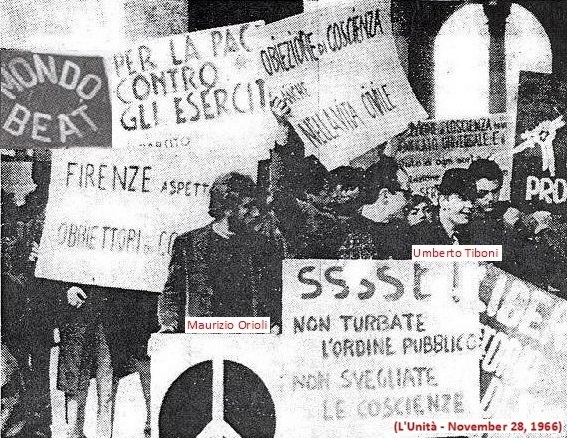
Umberto Tiboni is pictured in one of the photos. In the same photo, Maurizio Orioli. (L'Unità)
As the news of this demonstration spread, youths from Turin and Genoa came to Milan to join those of Mondo Beat. As a result, the Mondo Beat Movement spread from Milan throughout the northwest of Italy, which was the most industrialized area of the country.
On December 1, in the Milanese section of the radicals, Gunilla Unger and Melchiorre Gerbino were introduced to Gianfranco Sanguinetti and Andrea Valcarenghi. These two youths were of a group called "Onda Verde" (Green Wave). On that occasion, the four considered how to coordinate Onda Verde and Mondo Beat. To discuss it thoroughly, they met on 4 December, at Gianfranco Sanguinetti's home. On this occasion Melchiorre Gerbino explained how the Mondo Beat youths, which were of all social classes and from every part of Italy, were characterized by the refusal to undergo wage work, to attend school, to live in the family. He said there were about 200 of them, taking into account those who were in Florence to help after the flood and those who were in prison for not having complied with police injunctions to leave Milan and return to their hometowns.
Gianfranco Sanguinetti and Andrea Valcarenghi were youths who attended the last year of high school. Together with their schoolmates Antonio Pilati and Marco Maria Sigiani they led Onda Verde, a group of around twenty students engaged in nonviolent provocations aimed at raising awareness of pacifism and ecology in secondary schools. They were well informed, as they were children of the most enlightened Milanese bourgeoisie, and were openly committed to the affirmation of civil rights in Italy. Obviously Melchiorre Gerbino could not propose to them to be absorbed by Mondo Beat, so he proposed a merger of the two groups, to be formalized in the next issue of Mondo Beat magazine. They found the agreement without unnecessary skirmishes and decided to meet in mid-December at Andrea Valcarenghi's home to ratify the merger. This merger would certainly have benefited both groups, Mondo Beat, because prestigious articles by Antonio Pilati and Marco Maria Sigiani would have enriched the magazine, which would have deepened its roots in schools, Onda Verde, because it would have become part of a historical movement who occupied the squares and filled the prisons.
On 12 December we learned the terrible news of the death of Gennaro De Miranda
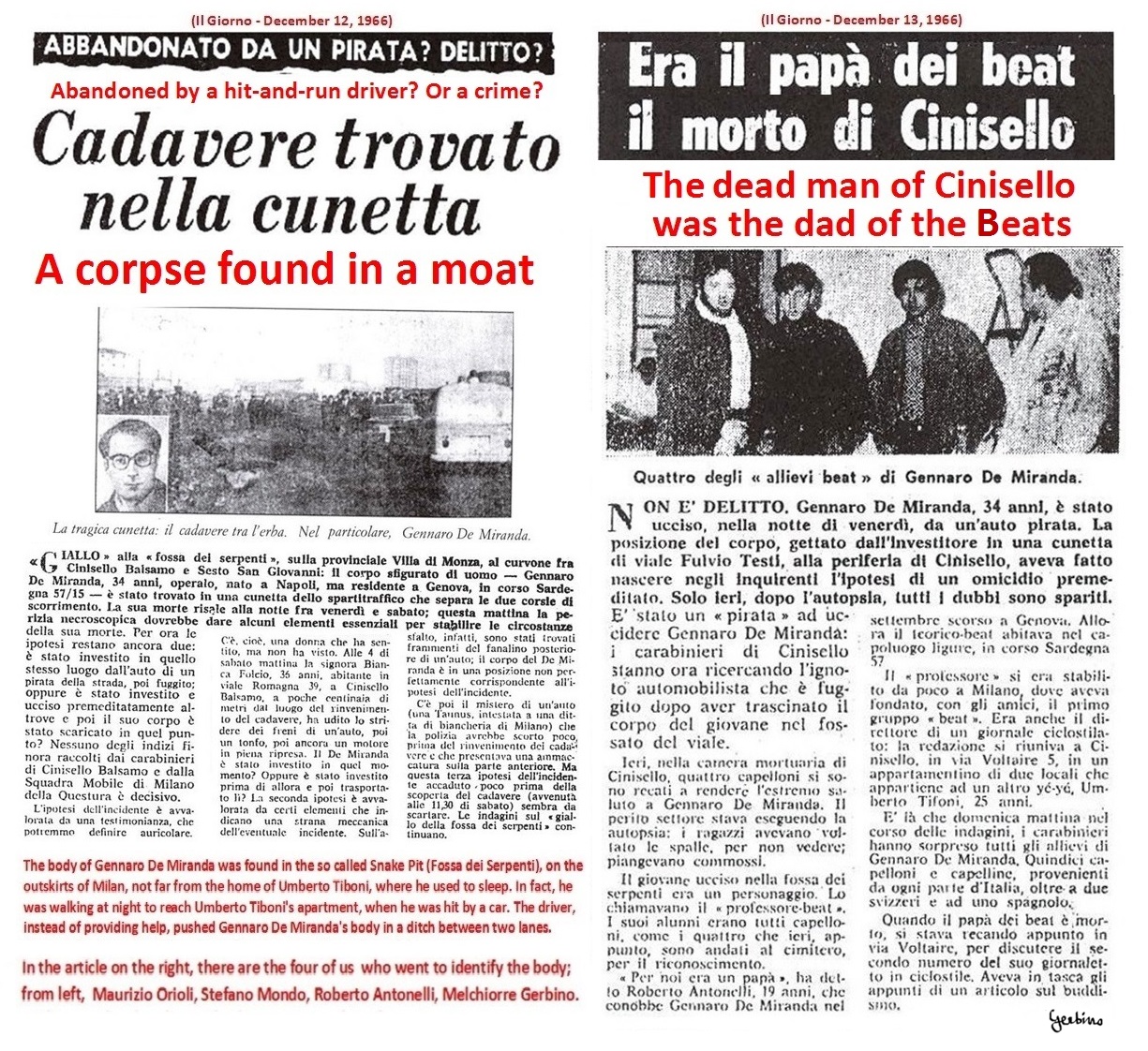
Gennaro De Miranda killed by a hit-and-run driver. (Il Giorno)
Gennaro De Miranda's body was found in the outskirts of Milan, in the so-called Fossa dei Serpenti (Snake Pit) which was not far from Umberto Tiboni's apartment, where Gennaro De Miranda used to sleep. He was in fact walking at night to reach that apartment when he was hit by a car. The driver, instead of providing assistance, pushed the body into a ditch between two lanes.
When we learned of Gennaro's death, four of us went to Cinisello Balsamo morgue to identify the body. In this sad circumstance Melchiorre Gerbino met a young journalist from the newspaper Il Giorno, Ezio Chiodini, who expressed his interest in following the events of the Mondo Beat Movement, so the two established contact with each other.
On the afternoon of December 15th, a meeting was held at Andrea Valcarenghi's house to ratify the merger between Mondo Beat and Onda Verde. There was also a representative of the Provos of the anarchist section Sacco and Vanzetti, who wanted to join the merger.
Representing Onda Verde were Antonio Pilati, Gianfranco Sanguinetti, Marco Maria Sigiani and Andrea Valcarenghi, who delivered their articles to Melchiorre Gerbino for publication in Mondo Beat magazine.
For Mondo Beat there were Gunilla Unger, Umberto Tiboni and Melchiorre Gerbino.
Giuseppe Pinelli was there for the Provos of the Sacco and Vanzetti section, who suggested organizing a demonstration to celebrate the merger.
This merger would have had a historical significance, because from the moment it took place there would have been only one libertarian movement in Milan, which would have been first the beacon of the youth revolt in Italy, then one of the most important youth movements of the Sixties, because it would have opened the scenarios of the Contestation.
On the afternoon of Saturday 17 December, as suggested by Giuseppe Pinelli, an event organized and conducted by Pinelli himself took place. The participants gathered in Piazza Cordusio, from there they went to Piazza Duomo, where they performed a sit-in, and finally they went to the courtyard of the Police Headquarters, where they surrendered spontaneously.
This event, promoted for Vittorio Di Russo's release from prison, was very spectacular and received huge media coverage. It is remembered as "Demonstration of Flowers" (Manifestazione dei Fiori) because the participants offered flowers to the police.
Articles and photos from the Demonstration of Flowers
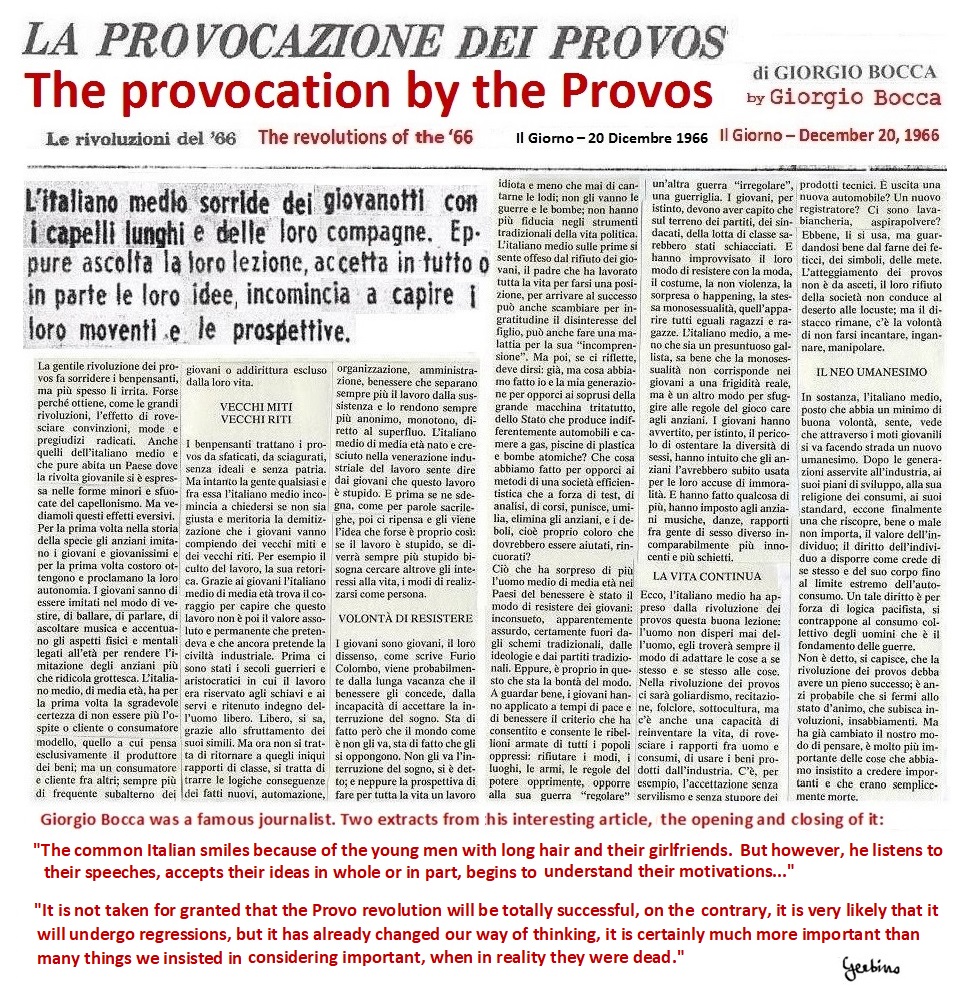
The provocation of the Provos. (Il Giorno)
Giorgio Bocca, who wrote this article, the most intelligent article ever written on the youth revolt in Italy, was the only journalist to immediately understand that the youth revolt was creating epochal changes.
Here is the translation of two excerpts from his article, namely the opening and closing of the same:
(Opening of the article) "The average Italian smiles when he sees the long-haired young men and their girlfriends. But nevertheless he listens to their speeches, accepts their ideas in whole or in part, begins to understand their motivations... "
(Closing of the article) "It is not certain that the Provo revolution will be completely successful, on the contrary, it is very likely that it will undergo regressions, but it has already changed our way of thinking, it is certainly more important than many things that we insisted on believing were important when in reality they were already dead."
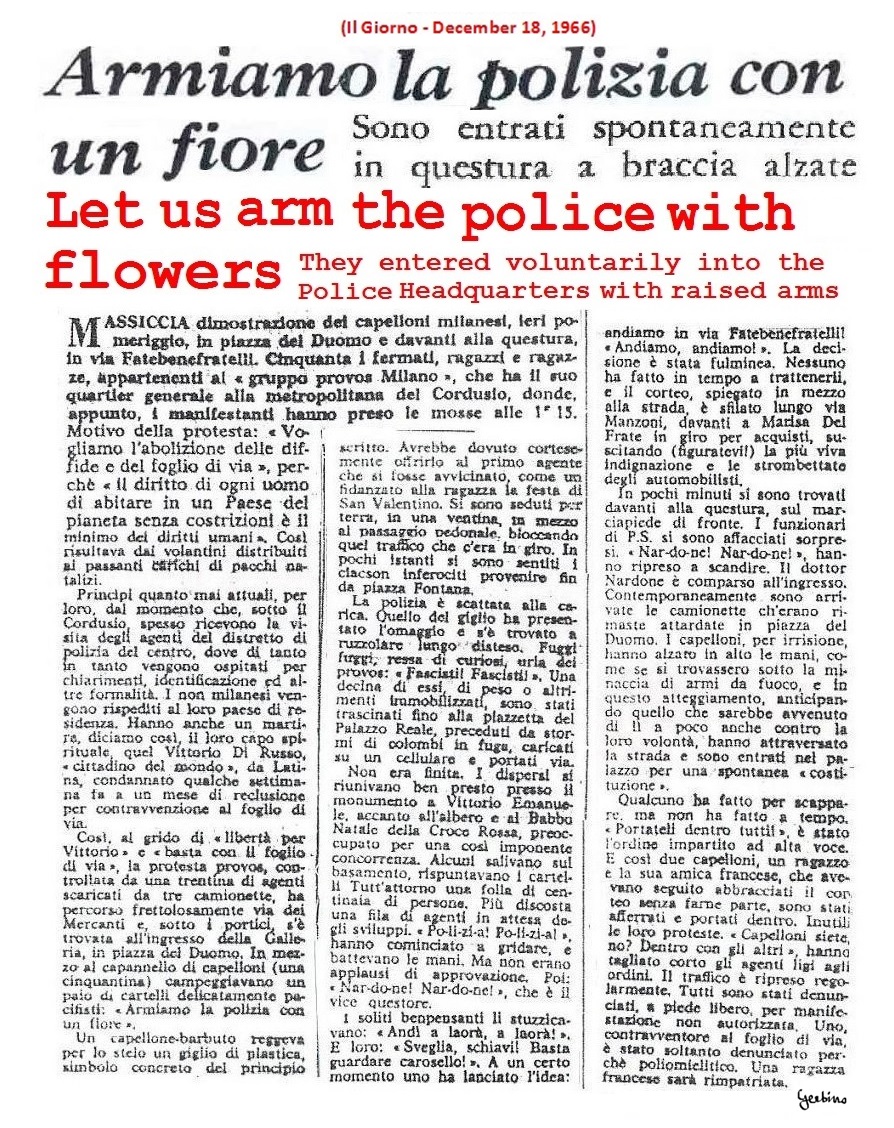
Let us arm the police with flowers. (Il Giorno)
In this second article Il Giorno, despite being a government newspaper, expressed a certain sympathy for the Movement, influenced as it was by Giorgio Bocca, who was the most prominent journalist of that newspaper, who was aware that a beneficial wind was blowing by the Movement for the renewal of Italian society.
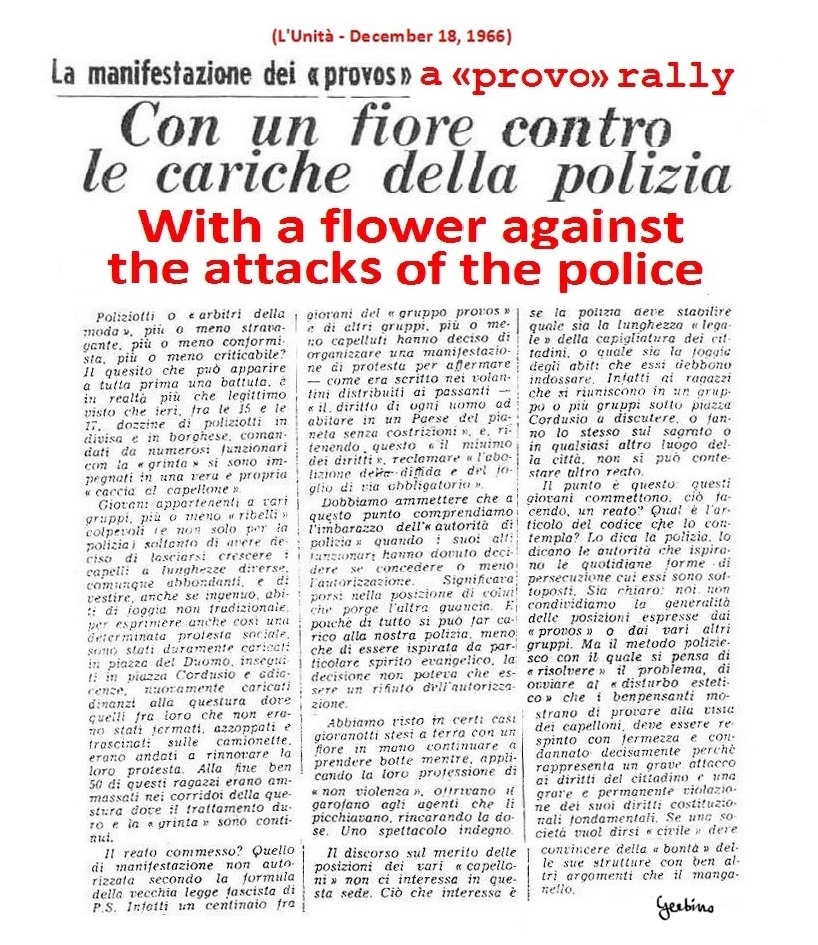
With a flower against police attacks. (L'Unità).
The communists courted the Movement in an attempt to incorporate it or gain support from it in their intent to destabilize the established power in Italy.
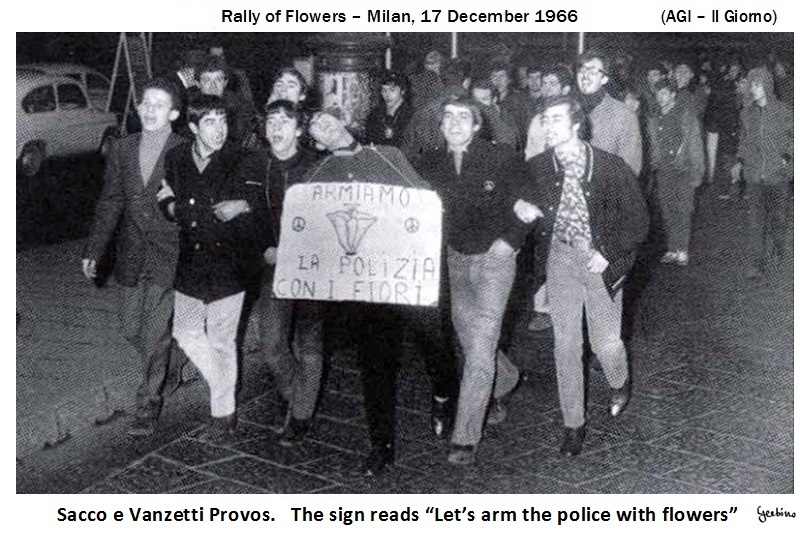
Provos from the Sacco e Vanzetti anarchist section moving towards Piazza Duomo.
The sign reads "Let's arm the police with flowers". (AGI - Il Giorno)
These youths were all Milanese high school students and had Giuseppe Pino Pinelli and Gianoberto Pinky Gallieri as references.
At this point, it is appropriate to speak of the mutation that traditional anarchists, like Giuseppe Pinelli, experienced in the Sixties. Prior to the Sixties, anarchists had resorted to violence as a systematic approach to change society, but due to the wide youth participation in the Free Speech Movement, the Provo Movement, the Mondo Beat Movement, nonviolent movements they appreciated, the anarchists conformed to principles of nonviolence and in fact joined these movements.
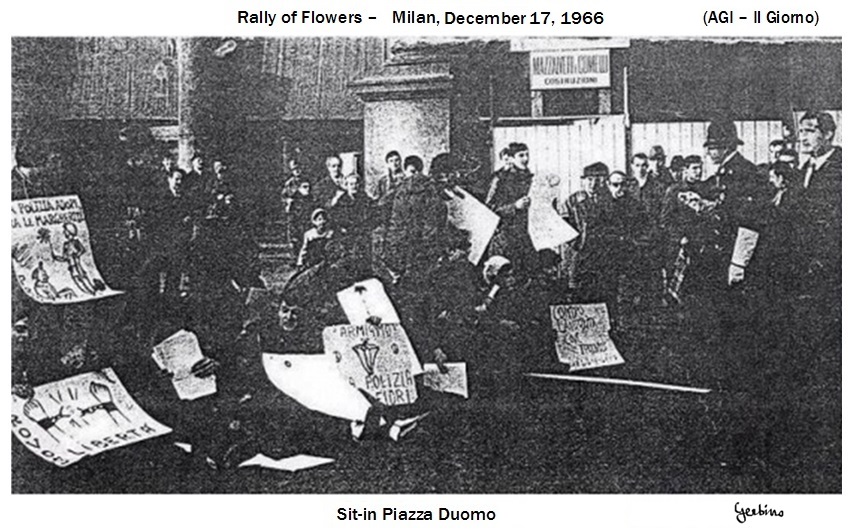
Sit-in Piazza Duomo. (AGI - Il Giorno)
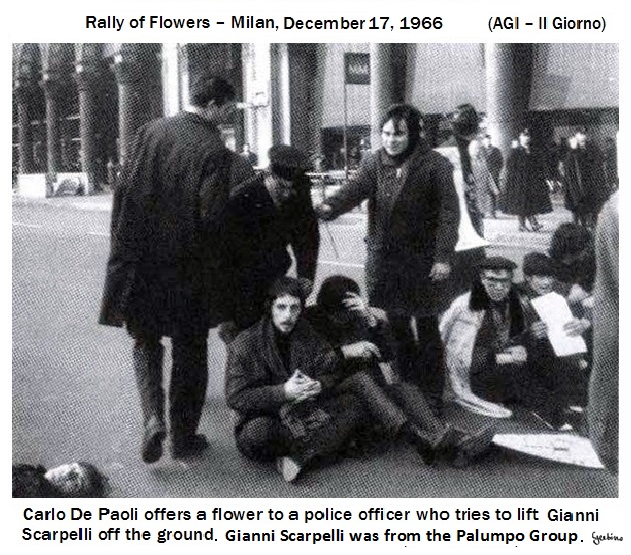
Carlo De Paoli offers a flower to a police officer who tries to lift Gianni Scarpelli off the ground. (AGI - Il Giorno)
Gianni Scarpelli was the leader of the "Gruppo Palumbo". This group consisted of 6 people only, but they were famous because they were imaginative and audacious. The group was called Palumbo because they met in an apartment at the door of which it was written "Palumbo", that is, the family name of the previous tenant. Carlo De Paoli was one of the most prominent young people from Mondo Beat.

Gianni Scarpelli forcibly lifted off the ground by a police officer. (L'Unità).
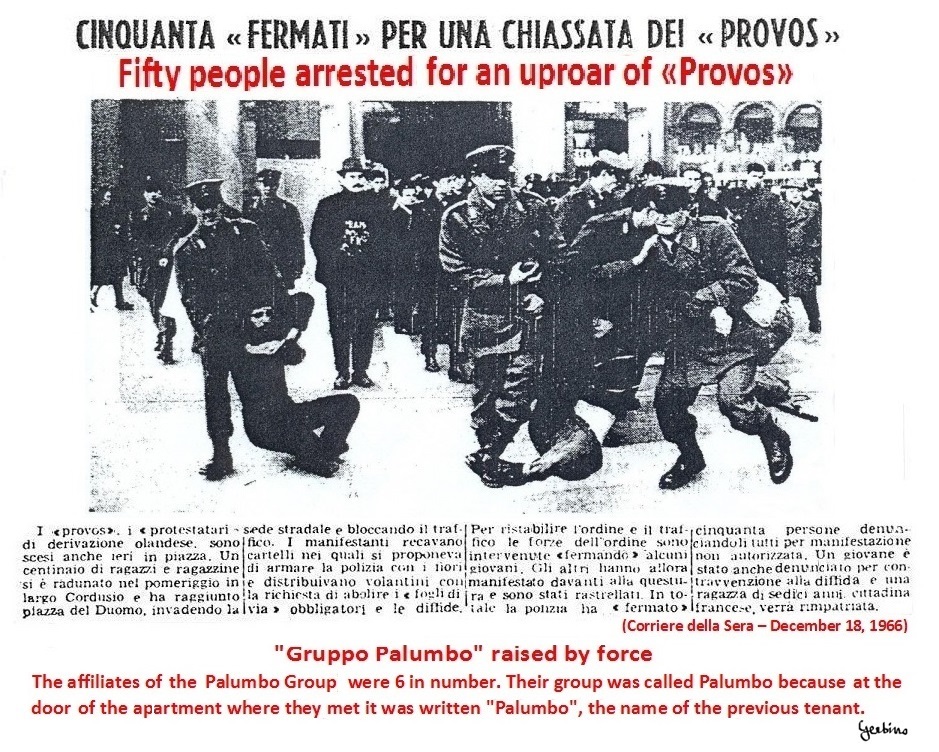
All 6 Palumbos lifted off the ground by the police. (Corriere della Sera).
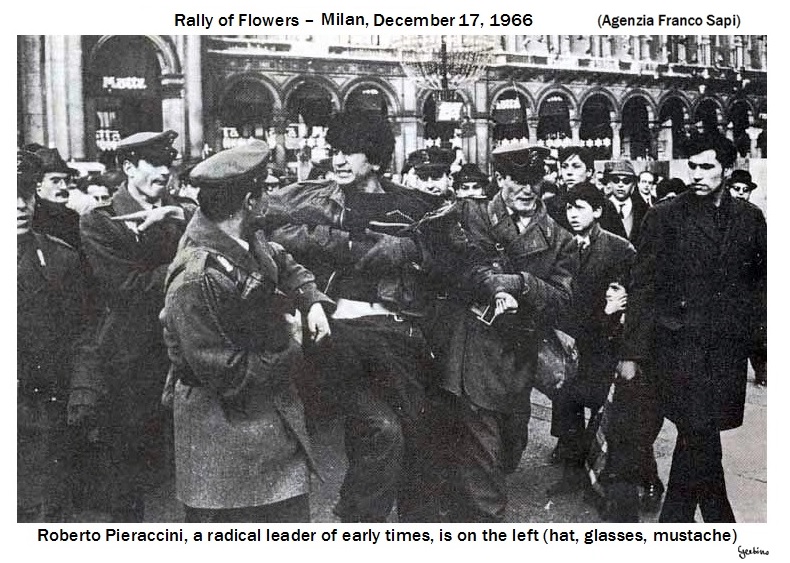
Roberto Pieraccini, one of the most prominent Milanese radicals of the time. (Agenzia Franco Sapi)
In this photo, Roberto Pieraccini is where the arrested activist seems to be pointing his finger (Roberto Pieraccini is the one with hat, glasses, mustache).
Police intervention was not violent but at the Police Headquarters they imposed mandatory expulsion orders on those activists who had not legal residence in Milan.
*
On the evening of 23 December 1966, Umberto Tiboni, Stefano Mondo and Melchiorre Gerbino went to the office where Umberto Tiboni worked, to clandestinely print the second issue of Mondo Beat magazine. In that office there was an electric mimeograph which printed dry sheets at high speed.
They had time to do the work from the afternoon of the 23rd until the early morning of the 27th, when the office was closed for the Christmas holidays.
They had to do a lot of work because they had to print 5,000 copies of an issue that consisted of 14 pages.
They worked all night on the 23rd and all day on the 24th, stopping every now and then just for a coffee and a sandwich. On the night between the 24th and 25th, Melchiorre Gerbino convinced Umberto Tiboni to load the mimeograph machine into his car and take it to the apartment where Gerbino lived, to work in a more comfortable situation and get help from Gunilla Unger. They finished the work on the night of the 26th.
Meanwhile, on the 24th, 25th and 26th, the European Conference of Anarchist Youth took place in the premises of the Sacco and Vanzetti section. The event, organized by Giuseppe Pino Pinelli and Gianoberto Pinky Gallieri, brought together young people from different parts of Europe, many of them Spanish. The four of us, who printed the second issue of Mondo Beat magazine, did not have time to participate.
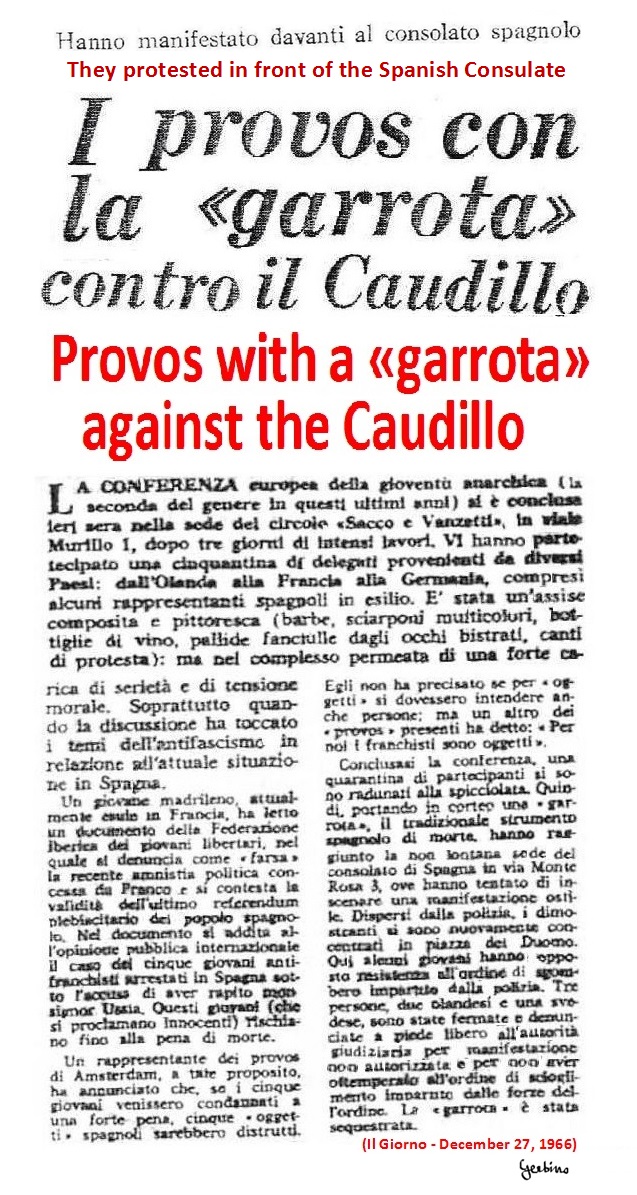
Provos with a garrota against the Caudillo.
The European Conference of Young Anarchists brought together youths coming from different countries, among which numerous were Spanish.
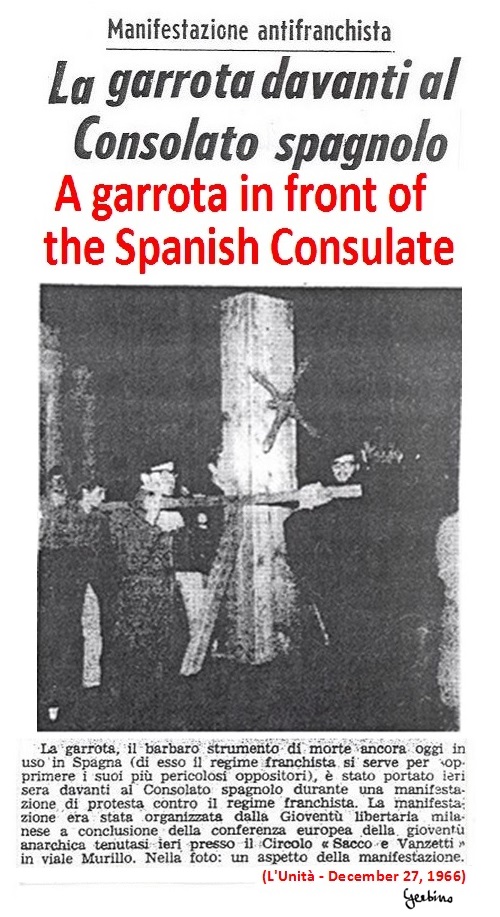
A garrota in front of the Spanish Consulate in Milan.
At the end of the European Conference of Anarchist Youth, a demonstration took place in front of the Spanish consulate in Milan, where the Provos displayed a garrota as a sign of contestation of the dictatorship of General Francisco Franco.
On the night of the 29th, Gunilla Unger and Melchiorre Gerbino finished collating and stapling 5,200 copies of the second issue of Mondo Beat magazine. That same night Vittorio Di Russo rang the doorbell of their apartment and asked if he could hide there. He came from Latina, his city of residence, where he had been escorted by the police after being released from prison. Vittorio wanted to hide in Milan while a lawyer would have applied for the suspension of the expulsion order to which he had been subjected. But if in the meantime the police had noticed him in Milan, he would have been arrested and sentenced to 3 months in prison, so critical was his situation. And Melchiorre Gerbino and Gunilla Unger could notice how he suffered profound trauma due to the brutal treatment he had undergone at the Milan Police Headquarters before being sent to prison. They welcomed him warmly and assured him of their protection.
*
December 1966 marked the success of the Mondo Beat Movement. By the end of that month, hundreds of youths, from all social classes and from all over Italy, had joined the Movement. Young people understood that Mondo Beat was promoting a real revolution, because it was above all an existential revolution and they wanted to take part in it. Many fled their families to join the Beats. Many were the girls, as numerous as the boys, or even more.
(Various newspapers)

By the end of December 1966, that is, a few weeks after its foundation, the Mondo Beat Movement had already transformed Italian society.
In the photos reproduced in these articles, the faces of the young people are sad because the photos were taken in police stations where they were in custody before being handed over to their parents or sent to prison.
One of these articles tells the moving story of a young Sardinian thief who, arrested by the police and questioned about the rings he had stolen from several hotels, confessed to having donated them to the Beats.

















